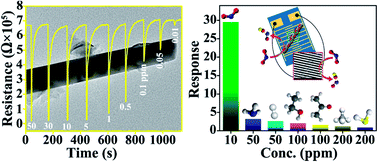Hydrothermally derived p–n MoS2–ZnO from p–p MoS2-ZIF-8 for an efficient detection of NO2 at room temperature†
Abstract
Two-dimensional transition metal dichalcogenides (2D-TMDs) and semiconductor metal oxides (MOs) have triggered enormous research attention in the fields of energy storage, catalysis, and gas sensing. However, the poor stability of TMDs in air and the high operating temperature of MOs remain critical bottlenecks for their application in practical gas sensing. In this work, a hydrothermal method was developed to convert rhombic p–p MoS2@ZIF-8 into rodlike p–n MoS2@ZnO heterostructure at 150 °C, which displays a large surface area, strong interaction between MoS2 and ZnO, and fast electron transportation. The as-synthesized p–n heterostructure was used to construct a gas sensor for the detection of NO2 at room temperature in air. The sensor showed an over 30-fold enhancement in the response compared to that of pristine MoS2 nanosheets and displayed short response/recovery time while lowering the detection limit of NO2 to 10 ppb. The sensor retained high stability upon sensing repetition for 10 consecutive weeks. This work demonstrated a facile strategy for the synthesis of p–n MoS2–ZnO heterostructures for reliable NO2 gas sensing at room temperature.

- This article is part of the themed collection: Journal of Materials Chemistry A HOT Papers


 Please wait while we load your content...
Please wait while we load your content...